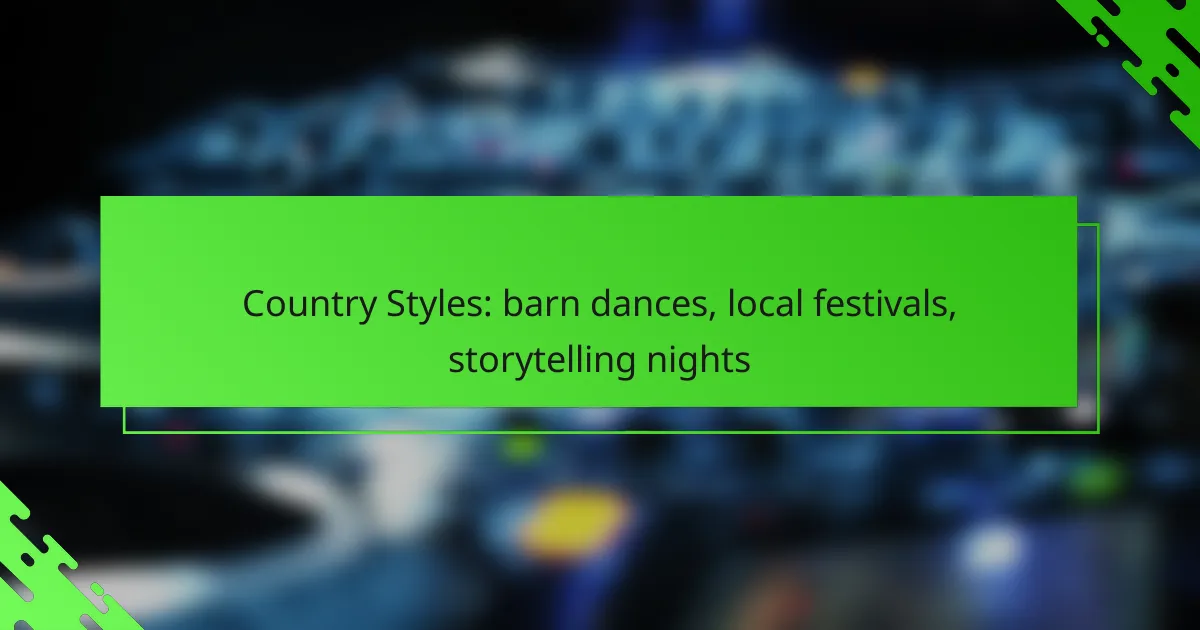Country styles such as barn dances, local festivals, and storytelling nights create vibrant opportunities for community engagement and cultural expression. Barn dances bring people together through lively music and traditional group dancing, while local festivals celebrate regional heritage with carefully planned events. Storytelling nights offer a cozy setting for sharing personal and cultural narratives, enriching the community’s connection to its roots.

What are popular barn dances in the UK?
Popular barn dances in the UK include traditional social gatherings that feature lively music and group dancing. These events foster community spirit and often showcase regional styles, each with unique characteristics and cultural significance.
Ceilidh in Scotland
Ceilidh is a traditional Scottish barn dance that emphasizes lively folk music and energetic group participation. Typically accompanied by a live band, ceilidhs involve a variety of dances, including reels and jigs, which are easy to learn and suitable for all ages.
Participants often form circles or lines, and a caller guides them through the steps, making it accessible for beginners. Ceilidh events are common at weddings, festivals, and community gatherings throughout Scotland.
Square Dance in England
Square dance in England is a popular form of barn dance characterized by four couples arranged in a square formation. This style combines elements of folk music with structured dance patterns, often led by a caller who instructs dancers on the moves.
Square dancing is typically lively and social, making it a great choice for community events. It encourages interaction among participants, fostering a sense of camaraderie and fun.
Barn Dance in Wales
Barn dance in Wales features traditional Welsh folk music and a variety of dances that often include lively steps and formations. These dances are usually accompanied by instruments such as fiddles and accordions, creating a festive atmosphere.
Welsh barn dances are popular at local festivals and gatherings, where community members come together to celebrate their culture. The inclusive nature of barn dancing allows people of all skill levels to participate and enjoy the experience.

How to organize a local festival?
Organizing a local festival involves careful planning, coordination with local authorities, and community engagement. Key steps include securing permits, selecting an appropriate venue, and collaborating with local vendors to create an enjoyable experience for attendees.
Planning permits and licenses
Before hosting a local festival, it’s essential to obtain the necessary permits and licenses from local authorities. This may include event permits, health and safety approvals, and noise ordinances. Start the application process early, as it can take weeks to finalize all required documentation.
Check with your local government or municipal office for specific regulations that apply to your area. Some regions may have unique requirements, such as insurance coverage or environmental assessments, which can impact your planning timeline.
Choosing a venue in rural areas
Selecting the right venue is crucial for the success of your festival, especially in rural areas where options may be limited. Consider open spaces like parks, community centers, or farms that can accommodate large crowds and provide necessary facilities.
Evaluate the venue’s accessibility, parking availability, and amenities such as restrooms and electricity. It’s also wise to have a backup plan in case of inclement weather, such as an indoor location or tents to ensure the event can proceed smoothly.
Engaging local vendors
Local vendors play a vital role in enhancing the festival experience by offering food, crafts, and entertainment. Reach out to nearby businesses and artisans to participate, as this fosters community spirit and supports the local economy.
When engaging vendors, consider creating a balanced mix of offerings to appeal to a diverse audience. Establish clear guidelines regarding fees, setup times, and health regulations to ensure a smooth collaboration. Aim to feature vendors that reflect the unique culture and flavors of your area to enrich the festival atmosphere.
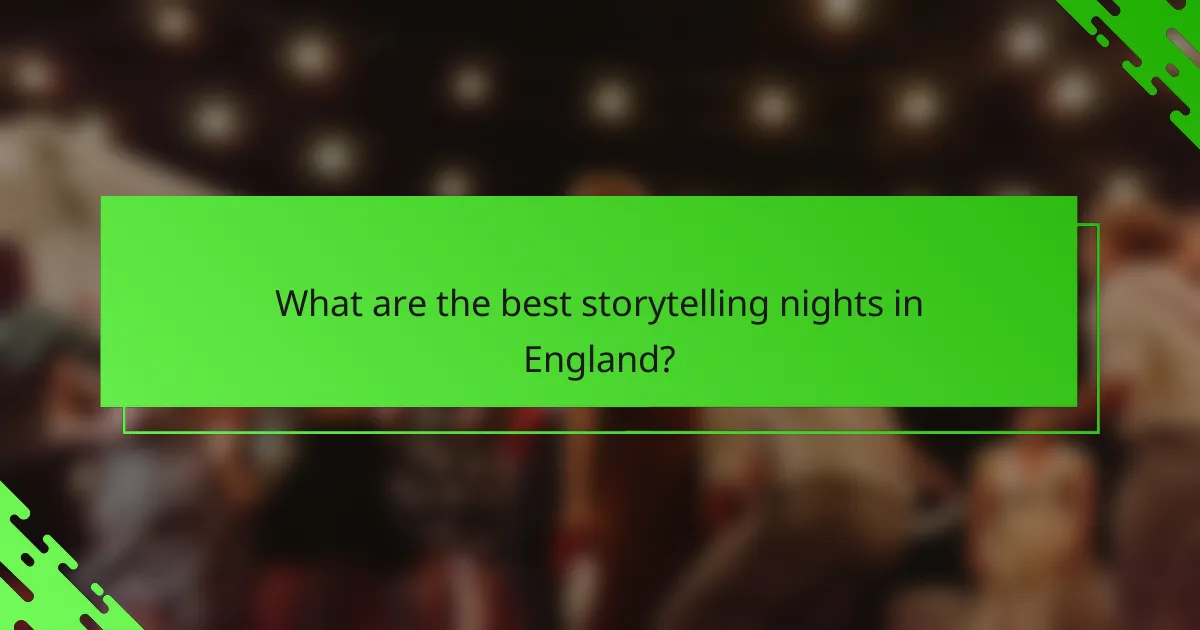
What are the best storytelling nights in England?
The best storytelling nights in England offer engaging experiences where local storytellers share tales that reflect cultural heritage and personal narratives. These events often take place in cozy venues, fostering a sense of community and connection among attendees.
Storytelling at The Moth in London
The Moth in London is renowned for its captivating storytelling nights, where individuals share true stories from their lives. Each event typically features a theme, and participants can sign up to tell their stories in front of an audience, creating an intimate atmosphere.
These storytelling sessions are held regularly, often in unique venues across the city. Attendees can expect a mix of humor, drama, and inspiration, making it a memorable night out. Tickets are generally affordable, ranging from £5 to £15, depending on the venue and event specifics.
Local storytelling events in Manchester
Manchester hosts a variety of local storytelling events that celebrate the city’s rich cultural tapestry. Venues like The Whitworth and various community centers frequently organize storytelling nights, inviting both seasoned storytellers and newcomers to share their narratives.
These events often emphasize community involvement, encouraging audience participation through open mic segments. Admission fees are usually modest, often around £3 to £10, making it accessible for everyone. Keep an eye on local listings to find upcoming events and themes that interest you.
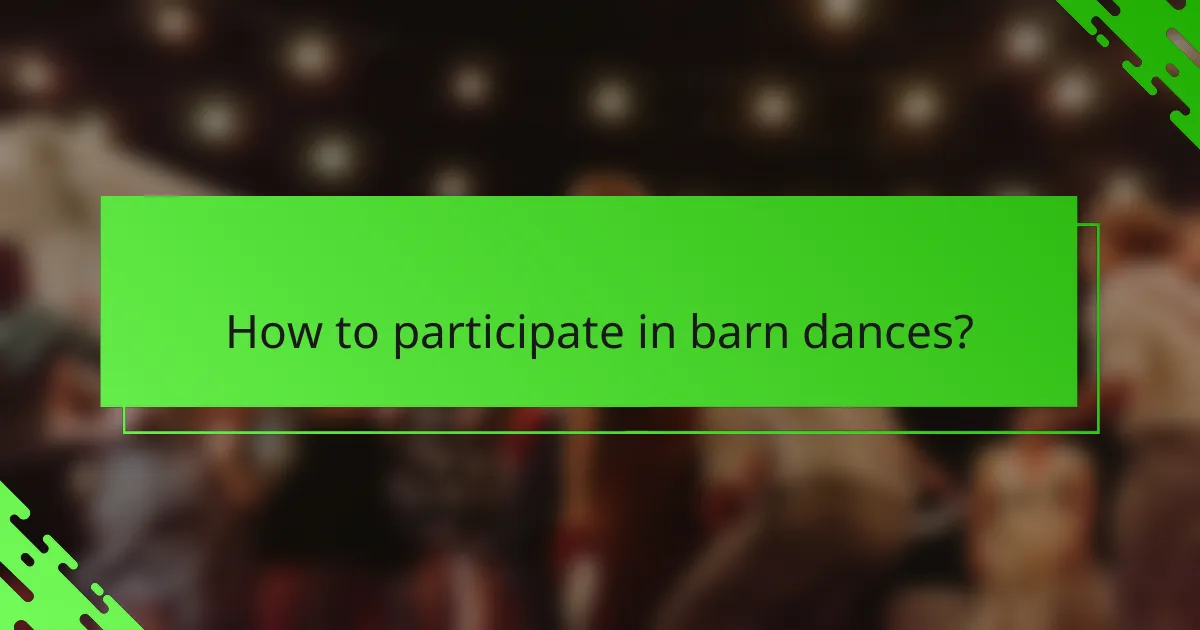
How to participate in barn dances?
Participating in barn dances involves attending local events where traditional folk dancing takes place, often accompanied by live music. These gatherings are community-oriented and welcome dancers of all skill levels, making them accessible and enjoyable.
Finding local barn dance events
To find local barn dance events, check community boards, social media groups, and local event calendars. Many towns and rural areas host regular dances, especially during harvest season or local festivals.
Websites like Meetup or Eventbrite can also help you discover upcoming barn dances in your area. Additionally, local dance studios or community centers may offer information on scheduled events.
What to wear for a barn dance
When attending a barn dance, wear comfortable clothing that allows for movement. Denim jeans or skirts paired with a fitted top are popular choices, as they provide both style and flexibility.
Footwear is crucial; opt for sturdy shoes or boots that offer good support. Avoid flip-flops or overly formal shoes, as they can hinder your ability to dance comfortably. Accessories like bandanas or hats can add a fun touch to your outfit while keeping you cool.

What are the benefits of attending local festivals?
Attending local festivals offers numerous benefits, including fostering community connections and enhancing cultural appreciation. These events provide opportunities for social interaction, entertainment, and support for local traditions.
Community engagement
Local festivals serve as a platform for community engagement, bringing together residents from diverse backgrounds. They encourage participation in cultural activities, workshops, and performances, which can strengthen community bonds and create lasting memories.
Engaging with neighbors at these events can lead to new friendships and collaborations. Consider volunteering at a festival to deepen your connection with the community and contribute positively to local culture.
Supporting local businesses
Festivals often feature local vendors, artisans, and food producers, providing them with a valuable opportunity to showcase their products. Attending these events helps stimulate the local economy by encouraging attendees to shop and dine locally.
When you support local businesses at festivals, you contribute to the sustainability of your community. Look for unique handmade items or local delicacies that you can enjoy while helping to keep your neighborhood vibrant and economically healthy.
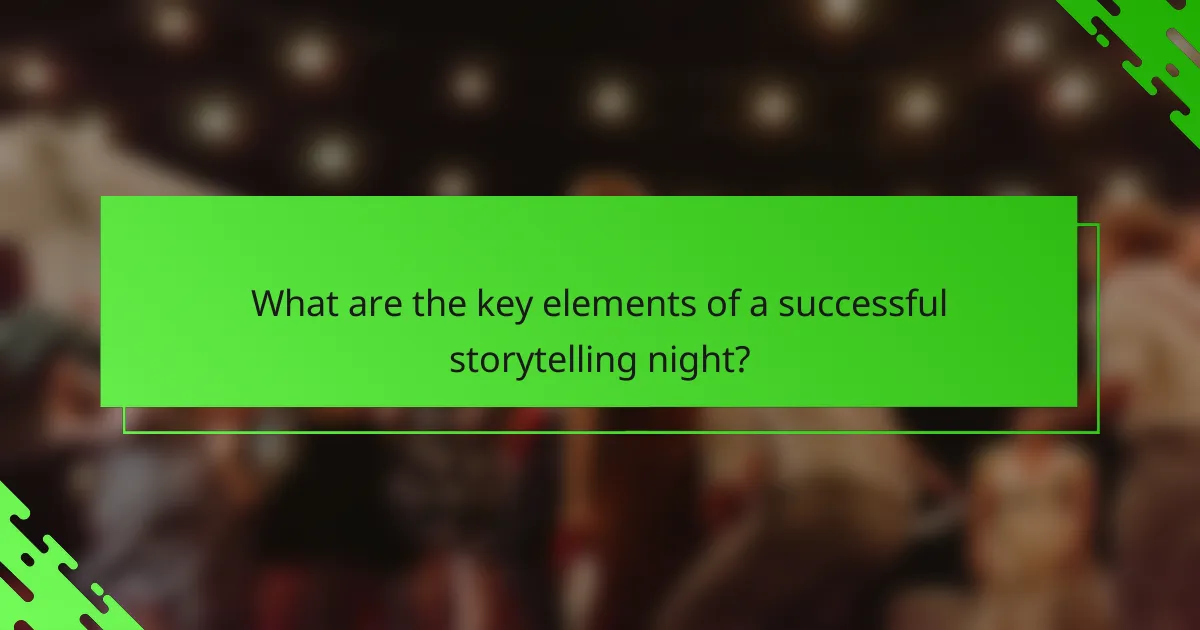
What are the key elements of a successful storytelling night?
A successful storytelling night hinges on captivating storytellers and a welcoming environment. These elements foster engagement and create memorable experiences for the audience.
Choosing engaging storytellers
Selecting the right storytellers is crucial for a storytelling night. Look for individuals who have a natural flair for storytelling, as well as the ability to connect with the audience. Personal stories that evoke emotion or humor often resonate best.
Consider a diverse lineup of storytellers to appeal to various interests and backgrounds. This can include local figures, community members, or even professional storytellers who can bring unique perspectives to the event.
Creating an inviting atmosphere
An inviting atmosphere enhances the storytelling experience. Choose a comfortable venue with adequate seating and good acoustics to ensure everyone can hear the stories clearly. Soft lighting and cozy decor can also help set the mood.
Incorporate elements like refreshments or themed decorations that relate to the stories being told. This not only makes the event more enjoyable but also encourages audience interaction and participation, making the night memorable.

How do barn dances compare to local festivals?
Barn dances and local festivals both offer unique social experiences, but they differ significantly in scale and atmosphere. Barn dances typically focus on communal dancing and music in a more intimate setting, while local festivals encompass a broader range of activities, including food, crafts, and entertainment, often attracting larger crowds.
Social interaction differences
At barn dances, social interaction is often more personal and direct, as participants engage closely with one another while dancing. The environment fosters a sense of community, where everyone can easily join in and connect with others.
In contrast, local festivals tend to facilitate more casual interactions among attendees. With various booths and activities spread out, people may engage in brief conversations rather than deeper connections. This setting can lead to a more diverse range of social encounters, but they may lack the intimacy found at barn dances.
Types of entertainment offered
Barn dances primarily feature live music and dancing, often with a caller guiding participants through traditional dance steps. This focus on dance creates an engaging atmosphere where everyone can participate, regardless of skill level.
Local festivals, however, provide a wider variety of entertainment options. Attendees can enjoy live performances, art displays, food tastings, and games, catering to different interests. This diversity allows for a more varied experience, appealing to families and individuals seeking different forms of enjoyment.
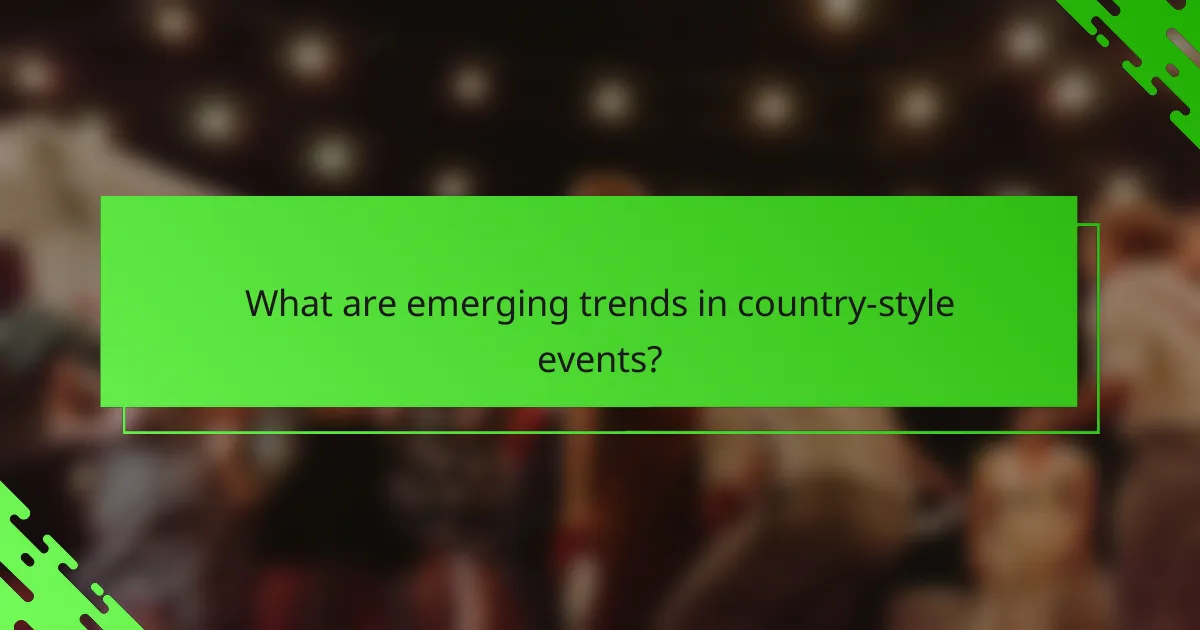
What are emerging trends in country-style events?
Emerging trends in country-style events include a revival of traditional activities like barn dances, increased community engagement through local festivals, and a growing interest in storytelling nights. These trends reflect a desire for authentic experiences that foster connection and celebrate local culture.
Barn Dances
Barn dances are experiencing a resurgence, often featuring live music and calling to engage participants. These events typically encourage community participation, with attendees of all ages joining in traditional dances like square dancing or line dancing.
To host a successful barn dance, consider securing a spacious venue, such as a barn or community hall, and hiring a local band familiar with folk music. Providing clear instructions and a welcoming atmosphere can enhance the experience for newcomers.
Local Festivals
Local festivals are becoming more popular as communities seek to showcase their unique culture and traditions. These events often include food vendors, craft booths, and entertainment, creating a festive atmosphere that attracts both locals and visitors.
When organizing a local festival, focus on highlighting regional specialties, such as traditional foods or crafts. Collaborating with local businesses and artists can enhance the festival’s appeal and foster community pride.
Storytelling Nights
Storytelling nights are gaining traction as a way to share personal narratives and local folklore. These events provide a platform for individuals to connect through shared experiences and cultural heritage.
To create an engaging storytelling night, consider setting a theme that resonates with the audience, such as local history or personal journeys. Encouraging participation from community members can enrich the storytelling experience and foster a sense of belonging.
